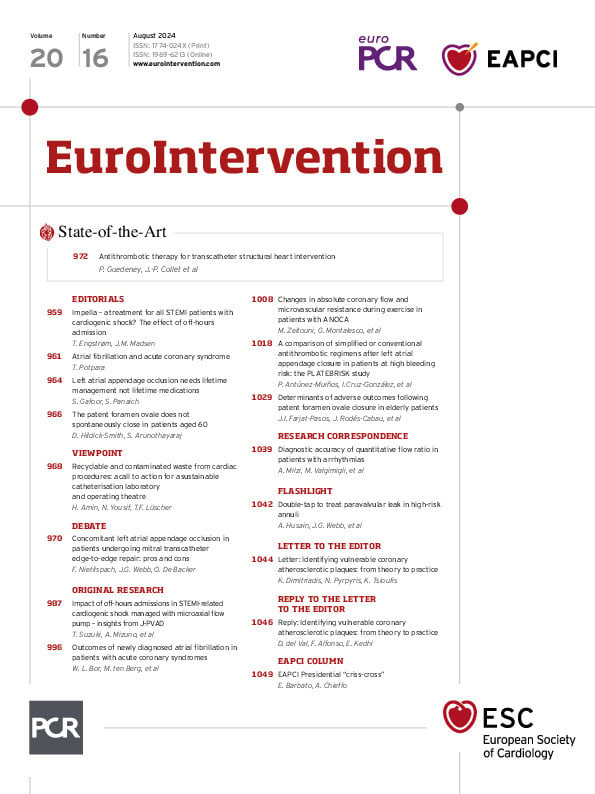In this issue of EuroIntervention, Antúnez-Muiños et al describe outcomes with different antithrombotic regimens following left atrial appendage occlusion (LAAO) in patients who are at very high bleeding risk1. Over 1,000 patients with very high risk of bleeding were included, with at least one major or two minor Bleeding Academic Research Consortium criteria. Two separate treatment options were compared – single antiplatelet or no therapy (397 patients) versus dual antiplatelet, oral or subcutaneous anticoagulation, or any combination of these therapies (738 patients). Technical success was >99% in all cases with a wide variety of devices. Periprocedural complications were <4% in both groups. Prior major bleeding varied between the two groups and was a predictor of the endpoint; however, there were no differences in the combined or individual components (death, ischaemic stroke, transient ischaemic attack, peripheral embolism, device-related thrombosis [DRT], and major bleeding) between the study groups. The incidence of DRT was less than 4%, comparable to previously published literature, although more than 50% of the patients were lost to follow-up at 2 years.
Do these patients exist? Absolutely. In patients with significant haematological abnormalities (anaemia, thrombocytopaenia), previous life-threatening bleeding, or non-deferrable major surgery, the risk of stroke and bleeding are very high. Post-LAAO anticoagulation regimens vary widely in practice and can range from full anticoagulation to single or no antiplatelet therapy, as noted in this study. We have varied data for these regimens, some more concrete than others, and this study provides important evidence in a field where more data are required. Despite significant improvements in device designs and technology, we still need our postprocedural antithrombotic regimens to mature. The authors in this study have demonstrated that the postprocedural antithrombotic regimen did not appear to posit safety or efficacy outcomes in a large patient population. However, more data are needed, and in our opinion, the field should focus on the following three points.
First, we should have the ability to tailor therapy according to individual patients and their risk profiles. The current scoring systems like CHADS2-VASc do not include various clinical and non-clinical factors like smoking, chronic kidney disease, left atrial size, morphology, emptying velocities, etc. They thus lack discriminatory value in identifying low-risk patients as well as the specificity to differentiate atrial fibrillation (AF)- from non-AF-related thromboembolic events2. Likewise, bleeding risk scores like HAS-BLED were derived from warfarin-anticoagulated patients; these scores have their own limitations, and revised scores have been suggested3. Post-LAAO antithrombotic regimens need to be tailored according to individual patient thromboembolic and bleeding risk profiles. As noted by the authors, there are multiple ongoing trials testing various antithrombotic regimens like low-dose anticoagulation, short-term dual antiplatelet therapy, etc. Although there are observational data for the efficacy and safety of a single antiplatelet regimen following LAAO, the upcoming SIMPLAAFY trial should provide additional data in this regard. While large multicentre registries are vital, a significant number of patients are often lost to follow-up, as was the case with this study, thus reducing the validity of results. Interconnected electronic medical record-based follow-up at a national level for 5 to 10 years may be one solution that allows us to gain more information in a large patient population.
Second, a well-defined imaging regimen is key to understanding the true incidence of DRT. Most patients undergo follow-up imaging to evaluate the LAAO device within the first few months post-implant. However, a large proportion of patients can develop DRT well after 3 months. In the present study, roughly 4% of patients presented with a DRT within 22 months, mostly identified by transoesophageal echocardiography, and no significant difference was noted between the two groups. Moreover, the lack of systemic embolism and extremely low stroke rates in all patients (<1%) was reassuring. However, there was significant heterogeneity in the follow-up imaging, and most patients did not have any additional imaging after the initial follow-up. In a case of “if you don’t look for it, it didn’t happen”, we must accept that there may be subclinical DRT that may have been missed in these patients. Thus, a move towards simplified antithrombotic regimens must be accompanied by long-term imaging protocols to identify subclinical DRT. Advanced imaging protocols like those used to detect methaemoglobin4, a component of fresh thrombus, might help earlier identification of DRT, while the application of computational fluid dynamics to cardiac computed tomography scans might improve our ability to predict the risk of DRT in individual AF patients during preprocedural planning.
Third, we need both procedural optimisation and improvements in device design to minimise the incidence of peridevice leak and thrombus. This starts with preprocedural planning with regard to device type and size, which should be individualised to patient anatomy. Optimisation of implant techniques including transseptal location, accurate volume loading and use of dedicated steerable sheaths could allow complete coverage of the left atrial appendage while avoiding a deep implant or a missed lobe. Improvements in device technology, like the addition of fluoropolymer coating to the fabric membrane in the WATCHMAN FLX Pro (Boston Scientific), are expected to potentially reduce DRT incidence. Novel approaches to closure (the Laminar system [Johnson & Johnson]) will bring additional insights to this area as well.
LAAO is unique in that it is likely the only procedure where patients can cut down on medications from their regimens. Moreover, unlike valvular and revascularisation procedures, LAAO is a one-time procedure with a prospective lifelong benefit. Risk-stratifying patients, optimising procedural outcomes, reducing DRT incidence, and identifying patients who might benefit from simplified postprocedural antithrombotic regimens, and especially single antiplatelet therapy, will go a long way in the further penetration of this therapy.
Conflict of interest statement
S. Gafoor is a consultant for Boston Scientific, Abbott, and Edwards Lifesciences. S. Panaich is a consultant for Edwards Lifesciences.

